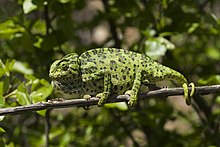
Summary
Acrodonta are a subclade of iguanian squamates consisting almost entirely of Old World taxa. Extant representation include the families Chamaeleonidae (chameleons) and Agamidae (dragon lizards), with at least over 500 species described. A fossil genus, Gueragama, was found in Brazil, making it the only known American representative of the group.[1]
| Acrodonta Temporal range: Early Cretaceous- present,
| |
|---|---|

| |
| Common chameleon, Chamaeleo chamaeleon | |

| |
| Common Agama Agama agama | |
| Scientific classification | |
| Domain: | Eukaryota |
| Kingdom: | Animalia |
| Phylum: | Chordata |
| Class: | Reptilia |
| Order: | Squamata |
| Suborder: | Iguania |
| Clade: | Chamaeleontiformes |
| Clade: | Acrodonta Cope, 1864 |
| Subclades | |
The group is eponymously named from their acrodont dentition, whereby the teeth are consolidated with the summit of the alveolar ridge of the jaw without sockets.[2] There are, however, other animals that have acrodont dentition such as tuataras.[3]
Systematics edit
Usually acrodonts are divided into two families Chamaeleonidae and Agamidae, there are a few studies that suggest chameleons are nested within Agamidae.[4][5] In order to maintain the familial status of Chamaeleonidae some authors suggested placing the clades Uromastycinae and Leiolepidinae in a third family Leiolepididae.[4][5] However a majority of papers concerning acrodont phylogenetics support the traditional dichotomy of the group.[6][7][8][9] The Acrodonta (lizard) is the oldest iguanian lizard from the African continent. Scientists just discovered new fossils of this lizard that date all the way back to the Mesozoic Era. This indicates that Acrodontan lizards had a widespread geographical distribution in Gondwana, the supercontinent that included Africa. Meaning that they had a extensive role in the evolution of lizards especially iguanas.
Below is the phylogeny of the acrodont lineages after Pyron et al. (2013):[8]
| Acrodonta |
| ||||||||||||||||||||||||||||||||||||||||||
The extinct Arretosauridae (Paleogene iguanians from Central Asia) are also sometimes classified in Acrodonta. However, other studies instead suggest it to be a sister group to the Crotaphytidae in Pleurodonta.[10][11] <refVullo, R., Bailon, S., Dauphin, Y., Monchot, H., & Allain, R. (2023, March). A reappraisal of Jeddaherdan Aleadonta (squamata: Acrodonta), the purported oldest iguanian lizard from Africa. NASA/ADS. https://ui.adsabs.harvard.edu/abs/2023CrRes.14305412V/abstract/ref>
References edit
- ^ Simões, Tiago R.; Wilner, Everton; Caldwell, Michael W.; Weinschütz, Luiz C.; Kellner, Alexander W. A. (26 August 2015). "A stem acrodontan lizard in the Cretaceous of Brazil revises early lizard evolution in Gondwana". Nature Communications. 6: 8149. Bibcode:2015NatCo...6.8149S. doi:10.1038/ncomms9149. PMC 4560825. PMID 26306778.
- ^ Plough, F.H.; Janis, C.M.; Heiser, J.B. (2002). Vertebrate Life (6th ed.). Prentice Hall. ISBN 0-13-041248-1.
- ^ Edmund, A. G. (1969). "Dentition". In Gans, C. (ed.). Biology of the Reptilia: Morphology A. Vol. 1. pp. 117–200. ISBN 9780122746017. Retrieved 16 August 2017.
- ^ a b Honda M, Ota H, Kobayashi M, Nabhitabhata J, Yong HS, Sengoku S, Hikida T (2000). "Phylogenetic Relationships of the Family Agamidae (Reptilia: Iguania) Inferred from Mitochondrial DNA Sequences". Zoological Science. 17 (4): 527–537. doi:10.2108/zsj.17.527. hdl:2433/57223.
- ^ a b Jacques A. Gauthier; Maureen Kearney; Jessica Anderson Maisano; Olivier Rieppel; Adam D.B. Behlke (2012). "Assembling the Squamate Tree of Life: Perspectives from the Phenotype and the Fossil Record". Bulletin of the Peabody Museum of Natural History. 53 (1): 3–308. doi:10.3374/014.053.0101. S2CID 86355757.
- ^ Moody, S. M. (1980). Phylogenetic relationships and historical biogeographical relationships of the genera in the family Agamidae (Reptilia: Lacertilia) (PhD). Ann Arbor: University of Michigan. 8017324.
- ^ Frost, Darrel R.; Richard Etheridge (28 September 1989). "A phylogenetic analysis and taxonomy of iguanian lizards (Reptilia: Squamata)". University of Kansas Museum of Natural History Miscellaneous Publications. 81. University of Kansas Museum of Natural History: 1–65. Retrieved 5 January 2012.
- ^ a b Pyron; Burbrink; Wiens (2013). "A phylogeny and revised classification of Squamata, including 4161 species of lizards and snakes". BMC Evolutionary Biology. 13 (1): 93. Bibcode:2013BMCEE..13...93P. doi:10.1186/1471-2148-13-93. PMC 3682911. PMID 23627680.
- ^ Zheng, Yuchi; Wiens, John J. (2016). "Combining phylogenomic and supermatrix approaches, and a time-calibrated phylogeny for squamate reptiles (lizards and snakes) based on 52 genes and 4162 species". Molecular Phylogenetics and Evolution. 94 (Pt B): 537–547. doi:10.1016/j.ympev.2015.10.009. PMID 26475614.
- ^ Alifanov, V. R. (2012-07-01). "Lizards of the family Arretosauridae Gilmore, 1943 (Iguanomorpha, Iguania) from the Paleogene of Mongolia". Paleontological Journal. 46 (4): 412–420. Bibcode:2012PalJ...46..412A. doi:10.1134/S0031030112040028. ISSN 1555-6174. S2CID 119087759.
- ^ Bolet, Arnau; Stubbs, Thomas L; Herrera-Flores, Jorge A; Benton, Michael J (2022-05-03). Zhu, Min; Perry, George H; Zhu, Min (eds.). "The Jurassic rise of squamates as supported by lepidosaur disparity and evolutionary rates". eLife. 11: e66511. doi:10.7554/eLife.66511. ISSN 2050-084X. PMC 9064307. PMID 35502582.


